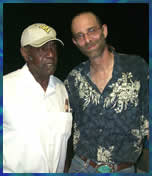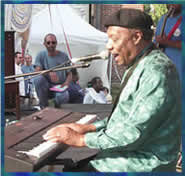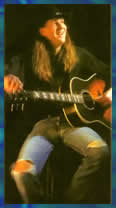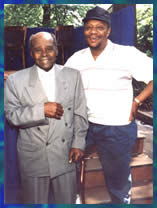"I'm
doing life without parole for the blues," says John May into
a well-worn microphone as he wears his fretless bass on stage
at B.B.'s
Blues, Jazz and Soup Club one dark and stormy Tuesday night. Leading
 |
|
Johnnie
Johnson & John May
|
his
trio Cryin' Shame, he stands beside a plastic jug that has "Musician's
401k Plan" scrawled on it. It holds a few worn, crinkled
dollar bills.
As May launches into an especially bluesy version of Tracy Chapman's
"Give Me One Reason," the modest crowd sways and nods
to the rhythm. One couple is oblivious to the band - a guy in
the back corner wearing a wedding ring is all over a woman who
isn't. Before the band finishes its set, the couple is out the
door and into his BMW Z3. Tomorrow he probably will wake up in
a big house, with a fat 401k plan and an upwardly mobile career.
And May? He'll play to a crowd that may or may not get bigger.
At 2:30 a.m. he'll load his equipment in the rain. At 4 a.m. he'll
finally get to bed. When asked if it's worth it, he waxes philosophic
without really answering the question, mostly because, like many
of the city's dedicated, working blues musicians, that question
can't be answered. Not in words, at least.
Their
lives may not be filled with glamour, but misicians like May
aren't totally unappreciated in the city. Hundreds of St. Louisans
turned out to see the Big Muddy Blues Festival, held on Laclede's
Landing over Labor Day weekend. Participants included four generations
of St. Louis players: Brian Curran (age 23); May (45); and Oliver
Sain (70). And "attending as a VIP with all the amenities,"
as May puts it, is 93-year-old Henry Townsend.
"The blues crowd is the most loyal because they don't follow
trends," May says on a break, clutching his tall ice water
with lemon and lime wedges. "They don't go out because
they read an ad in the paper that said the person that sold
the most records this week will be at the biggest theater, and
plunk down $150 a seat. They know they will go out and get a
good seat, not spend a lot of money, and have a better time."
It is impossible to talk blues in St. Louis without mentioning
May. He is president of the St. Louis Blues Society, works with
B.B.'s owner Marc O'Shaughnessy booking acts, and produces local
artists' CDs. Townsend, who has recorded the blues in every
decade since the 1920s, says of May: "In what he does,
he is better than anybody I know."
May was 11 years old when he moved to St. Louis from Colorado
in 1968. He is married to Judy-a woman, he says, "who has
the patience and strength to be married to a man like me"
- and has two children and a granddaughter. He plays every Tuesday
night at B.B.'s and has a day gig as a graphic artist.
When asked about the crowd's size, he shrugs and explains size
doesn't matte r-even though his gig of five years has him playing
only for the door's cover charge of $5 a person. "It's
very eclectic," he says. "The thing I get the biggest
thrill out of is that when I look out into the theater, I see
just as many women as men. I see blacks, whites, older people,
tapping their foot. I see people bring in their kids. I think
that's beautiful."
The chain-smoking May says he has never thought of moving anyplace
else, and though it might be short on rewards, St. Louis is
wealthy in talent.
"There's a lot of positive energy here," he says.
"The older players take people under their wing."
May speaks of the number of international stars who live in
the city, particularly Sain and Townsend. He also rattles off
names from bygone eras - Bonedaddy,
Buffalo Bob, Boo
Boo, Gumbohead. "These
are the icons of St. Louis music as far as I'm concerned,"
May says. "They've been playing since the '40s and '50s,
and are nationally and internationally recognized, and yet they
are right here. I don't think these guys get the respect they
should. Unfortunately in music, in most arts, if you want to
be recognized you almost have to leave your hometown."
But they don't.
 |
|
Oliver
Sain - mainstage Big Muddy,
John May in background
|
With
his beret tilted on his head, Oliver Sain
mulls over the selection of soups as a friend walks up and whispers
some bad news-the death of a mutual friend from the old days.
Sain shakes his head, then says someone should call Ike Turner
out in California, as he might want to come in for the funeral.
In 90 minutes B.B.'s will be packed. Half the club's patrons
will be on their feet dancing, while the other half bob and
sway in their seats. But for now, Oliver quietly eats his vegetable
beef soup, indulging questions with charm and generosity.
"I came to St. Louis in 1959 to play with Little Milton
one weekend, and I've been stranded ever since!" he says
with a laugh. But as one of the city's most successful musicians
this side of Nelly, there's more to Sain than that. He was in
Chicago for a while, but didn't care for it, finding it too
competitive. He ended up in St. Louis by default. "My wife,
who lived in Chicago, and I separated, so I just decided to
be here, you know? Why not? When you're young, you just go wherever
the hell, you know what I'm saying?"
In the early '50s and '60s, St. Louis was better for a bluesman
than many places. Sain has financial success today because he
started penning his own songs and had a couple of hits, including
"Don't Mess Up a Good Thing," which was subsequently
recorded by Greg Allman and Conway Twitty, among others. With
the royalty check from that song he built Archway Studios in
1965.
In those days, says Sain, St. Louis was alive with R&B music.
"There were many black social clubs, two or three every
weekend, five-hundred to eight-hundred people at the club at
the time. That could never be again."
In recent years, R&B has ceded the throne to hip-hop-a development
that Sain doesn't care for. On the other hand, P. Diddy sampled
one of his hits on the multi-platinum No Way Out, adding considerably
to Sain's royalties. But his heart is in the blues. Besides
the better-paying corporate gigs, B.B.'s is the only club he
plays. "This joint is a labor of love, know what I'm saying?"
he says. "You want so much for it to be successful."
Like others, Sain thinks St. Louis could go a lot further in
promoting its blues scene. "You go to New Orleans, they
sell the music," Sain says. "Memphis? They sell the
music, you know what I'm saying? Here, they don't care. Naturally,
the black musicians would say, 'Oh, they don't support the blues.'
I say hell, they don't support Dixieland neither! And this is
a river town!"
Sain politely shakes my hand, goes to the stage and takes up
his tenor sax. The first set is pure blues, his tone is warm,
and his solos sing, honk and buzz with bebop influence. The
second set finds him behind the keyboard, picking up the tempo
with R&B. The crowd goes wild when he launches into "Don't
Mess Up a Good Thing."
At
the same moment, across the street at Beale On Broadway, Brian
Curran is on stage. On his break he'll come over to watch
Sain. "Oliver is a legend," he says. "He goes
to Germany and people know who Oliver Sain is. We have quite
a town of great musicians," Curran included, according
to May. Curran plays in the "pre-war" blues style-and
that's World War II. He makes his living playing at least six
gigs a week, supplementing that income with guitar lessons.
 |
|
Brian
Curran
|
On
a Saturday afternoon at Mike & Mins, he sits down to talk.
With long hair, a Stevie Ray Vaughn hat and an ever-present
cigarette, he tries to explain how a kid who grew up in Oakville,
a South County neighborhood, is now making a living playing
a gritty Mississippi Delta-style guitar. Curran has played guitar
since he was 13. He grew up listening to whatever his father
had on the stereo, but then he heard some John Lee Hooker, and
that was that. Soon he was attending local jam sessions and
hanging out at smoky bars, where the teenage Curran would play
with the city's greats.
He is pleased with the St. Louis scene. "All the musicians
are very supportive of each other," he says, lighting another
cigarette. "Everyone is open to each other's gigs. It's
cool because you get a job that pays not very much, you hang
out, start talking to some cat, and they're like, 'Oh yeah,
we just played this place in St. Charles. It's cool, pays $500,
go check it out.' Nobody's hiding their gigs."
At the same time, he doesn't plan to spend his life eking out
a living playing for the door at St. Louis clubs and making
the occasional CD. "I know I'm not only going to be playing
in St. Louis and a few festivals around the Midwest when I'm
30. There's no doubt about it. I want to make St. Louis my home,
but I don't necessarily want to make it my career," he
says. "I could make a decent living just being here in
St. Louis. But then what's my music for?"
For now, it's for the patrons of Mike & Min's. Curran excuses
himself, pulls an empty chair from the table and turns off the
television. There are seven people in the bar, including the
bartender and the cook. Curran lifts his Gibson guitar out of
the case, and along with his sweet voice plays the bleating,
harsh, raw blues.
During the first set, a family wanders in for lunch, not knowing
they'll get to hear one of St. Louis's rising blues stars for
free. When they walk out an hour later, the dad gives his little
girl a couple of dollars, which she puts in a jar at Curran's
feet. Curran tips his hat, smiles, then beats a steady rhythm
with his boot as he plays a heartfelt "Amazing Grace."
When
you're on the trail of St. Louis Blues, all roads might lead
through John May, but they lead to Henry
Townsend. His house in north St. Louis is the Mecca of blues,
and many blues musicians make the pilgrimage. "I went to
Henry's house, and he's one of nicest guys you'll ever meet,"
Curran says. "He's very supportive of young musicians.
And he still does things on piano that cats in St. Louis who
are 35 years old can't do." And Curran is hardly the only
local blues artist who has been influenced by Townsend. "I
got to know Henry the last 15 years," says Sain. "A
wonderful artist. Henry's style is very unique. Very simple,
and I think he kinda makes up songs as he goes along!"
But
Townsend is no mere figurehead. He is currently on the cover
of Living Blues magazine, and is now mulling over a contract
from Switzerland. "But what's in this contract isn't what
we agreed on, so I'm not going to go," he says, throwing
the papers on the table. Not surprisingly, his blues nom de
plume is "Mule" (the title of his 1997 album).
 |
|
Henry
Townsend & Oliver Sain
|
Townsend
started playing blues guitar in the mid-'20s, supplementing
his income fronting as a shoe-shiner for a bootlegging operation.
He has played with many of the blues' greatest, including Walter
Davies and the legendary Robert Johnson. Townsend is also a
recipient of the NEA's National Heritage Award.
"The first time I met Oliver," he says of Sain, "was
in a bank. We were making deposits. He's a very down-to-earth
guy-at that time, as now, he was very famous. ..." He pauses,
leans forward a little in his wheelchair, smiles, and adds:
"Not patting myself on the back, but I was pretty famous,
too." Townsend tells other players, "You can't just
want to, you got to. You got to want to want to! Some of the
kids come to me, they already made it, and they are real good
- and that makes me feel real good."
Like Sain, St. Louis got Townsend by default. "Chicago
and I didn't much get along," he says. So is St. Louis
a good place to be a blues musician?
"Not really," he says. "It's a musician town,
but not a good place for advancing. You can work around and
make a dime or two. But I couldn't get St. Louis off my mind.
I've always liked this ol' town."
He talks proudly of the early days, when St. Louis started many
trends. For instance, years ago when someone was about to be
evicted, musicians would gather to play, fish would be fried
and money would be raised. "The musicians here-and I was
one of them-would help people keep from getting put out. [We
did that] quite a bit," he says.
Townsend raised four children, and has six grandchildren and
two great grandchildren. He lives with his wife in a modest
but nice home, a home that might seem inadequate for an international
artist who has influenced hundreds of musicians. Yet Townsend
has no regrets. "It's kind of a miserable life, the blues.
But you accept that if it's something you want to do."
Then he smiles. "But I've always felt good being a musician."
For these players, the blues life has no parole. That we enjoy
their music as they serve out their sentence is enough for them.
|

